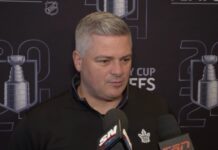 A month into the offseason, one thing can be said for sure about the steps the Toronto Maple Leafs have taken toward rebuilding the team: credit Brian Burke with having a plan, and sticking to it.
A month into the offseason, one thing can be said for sure about the steps the Toronto Maple Leafs have taken toward rebuilding the team: credit Brian Burke with having a plan, and sticking to it.
The beginnings of that plan are clearly reflected in the sweeping changes to the goaltending and defence corps this summer, as well as a noticeable infusion of truculence.
Speaking to the National Post, Burke elaborated on his philosophy:
“I built all my teams from the net out and blue line out. That’s no secret. Unless your defence can outperform the other team’s defence, you can’t win. And also, the simplest thing to righting a leaky ship in the NHL is reducing the number of pucks that go into your own net.”
That, in essence, is the basis of Burke’s plan for building a team: focus on the goaltending and defence, and then worry about the players up front. In his eyes, preventing goals is more of a key to winning than scoring them. If last year’s team — which ranked a very respectable 10th out of 30 teams for goals scored — is any indication, his theory on what it takes to win is right on the money.
The Plan In Action
Goaltending
In: Jonas Gustavsson
Out: Curtis Joseph
Arguably the team’s biggest concern last season was inconsistent goaltending. The team was in the middle of the pack (ranked 17th in the league) with 30.3 shots against per game, yet allowed a league-worst 3.49 goals against per game. Starting netminder Vesa Toskala, who entered the season with high expectations, often looked like his glove was made of swiss cheese. When he was finally shut down due to injury near the end of the season, speculation was his hip, groin, and shoulder were looking like swiss cheese also, a major contributing factor to his struggles.
Said Burke:
“When I took Vesa on publicly as far as his work habits, he was very angry and felt that it was unfair because he had medical issues and obviously it was born out that he was right … we’re confident that Vesa, having been surgically repaired, can be the guy here. But, it’s my job to add assets that push guys whether they like it or not.” (NHL.com)
Enter the competition: Jonas “The Monster” Gustavsson. While it is difficult to predict how successfully he will adapt to the NHL, the young Swedish free agent has put up outstanding numbers in the Swedish Elitserien, especially in the playoffs. To expect him to take over the starter’s role right away would be unrealistic; however, expectations are that he will provide a necessary push to both Toskala and young netminder Justin Pogge.
Says coach Ron Wilson:
“Vesa is like any other athlete . . . he needs a little competition, a little push from behind. Hopefully he’ll get back to playing the way everyone thinks he can.” (The Star)
If Toskala’s play improves this year, be it from a return to health or a level of competition that he did not have last season, the team will find itself with a host suitors come the trade deadline (assuming Gustavsson is playing well enough to take over by that point). If for any reason Gustavsson does not pan out, the Leafs can easily re-sign Toskala or pursue other options in the free agent market (Pekka Rinne, Chris Mason, Evgeni Nabokov are all UFAs next summer). Not to mention that Justin Pogge will be given the benefit of another year in the AHL to develop his game, with the added incentive of having to prove himself on a whole new level in the face of tougher competition on the big club.
Through his signing of Gustavsson to a one-year deal, which includes a team option to re-up before the player reaches RFA status, Burke has provided not only competition for the incumbent players and the subsequent challenge for them to raise their level of play, but also organization latitude for planning future moves. At the end of the season, he can walk away from all of his goaltenders if he chooses … and if Gustavsson is everything they hope he can be, they have given themselves the opportunity to keep him in the fold at a bargain price for another season.
Defence
In: Francois Beauchemin, Garnet Exelby, Mike Komisarek
Out: Jay Harrison, Pavel Kubina, Jamie Sifers
You’ve all heard it before: defence wins championships. And few believe that more strongly than Brian Burke. With the signings of Beauchemin and Komisarek, and the trade for Exelby, Burke has made his defense corps deeper, more talented, and much tougher to play against.
Burke has made his priorities for the defence corps clear on several occasions:
“My teams are physical teams. I want a bigger, more hostile team. I have not been able to do that yet. We need more bite.” (The Sun)
“We shoot for a top-four group that has a high skill level, the bottom two guys we look to do the plumbers’ work, which are really important jobs.” (The Hockey News)
“You need some bite back there (on defence). You need some knuckles on the blue line, too, some five-minute majors. I think with the changes we’ve made, there’s some bite there, there’s some size there.” (The Star)
“If you have toughness, it is a tool in the toolbox like goaltending and like team speed. Toughness is one of the attributes that can allow you to win a game, and I think your young players develop quicker if they’re in a fear-free environment.” (CBC)
Burke left little doubt that he was tired of watching his team get pushed around. Far too often last season, Leafs‘ defenders could not control the opposition in their own zone, and players were guilty of backing down much more frequently than standing up for themselves or their teammates. That will be the case no longer, with heavy hitters (and willing pugilists) such as Komisarek, Exelby and Beauchemin around.
But the intimidation factor is only a part of what Burke is building with his defense. He has also added skill the blueline with his acquisitions: Komisarek is regarded as an excellent two-way player whose struggles last season can be attributed to team-wide collapse in Montreal; Beauchemin made his name in Anaheim as a reliable, intelligent defensive presence; and Exelby has fostered a reputation as one of the more effective crease-clearing defenders in the game.
Most importantly of all, Burke has brought in players who will emphasize accountability; not just with their own teammates but with the opposition as well. This group will not be easy for anyone to play against, and liberties taken against the smaller, more skilled players will carry a heavy price.
Forwards
In: Colton Orr, Colin Stuart, Rickard Wallin
Out: Boyd Devereaux, Ryan Hollweg, Kris Newbury, Tim Stapleton, Jeremy Williams
Now that the goaltending and defence have been addressed, one would expect the next step in Burke’s plan would be to round out his forward unit with both grit and skill. When it comes to constructing forward units, Burke again believes in building from the back end up:
“The bottom six forwards are expected to fill and perform hard-hat functions. The plumber’s function. These are guys that are going to have to get their hands dirty, our fighting comes from that group, our PK comes from that group, our shot blocking. That is the energy. The other guys (top six), maybe they’re the guys sitting on top of the float in the parade. These are the guys that keep the engine running.” (CBC)
Indeed, Burke’s first move in free agency was to pursue a heavyweight to protect his skill players up front. His reasoning behind it was simple: the skill players must be allowed to do what they do best.
“You don’t want your heavyweight to be a defenceman, the ice time is too valuable. That’s why we got Colton Orr … sometimes Grabovski spent more time on the ice than the Zamboni. (Our forwards) were getting knocked down and picking their teeth out of the glass all year. Let’s see how they do with a little toughness around.”
If Burke is looking to improve his forward unit, he is starting in the right place. Adding a top scorer is much more difficult than adding toughness and character. Although a top offensive threat has not been acquired, the addition of Orr should allow the Leafs‘ existing skill players more room to maneuver, facing less harassment from the opposition.
At the same time, Burke remains committed to injecting skill and leadership into his team, as evidenced by the recent signing of another Swedish Elitserien star, Rickard Wallin, who has won just about everything there is to win at the international level. Burke made clear the priorities for his team, when asked about the signing:
“(Wallin) is a strong two-way (player) that will provide a solid presence in our dressing room.” (TSN)
Two-way play, leadership, and accountability were what caught Burke’s eye with Wallin. That and the advantage of an affordable commitment, too (one year, 900k plus bonuses). Clearly, Burke’s philosophy is that attitude trumps skill, and before you can focus on the skill players you must first set the proper tone in the locker room with players who know what it takes to win both on the ice and off it, and are willing to compete for their jobs.
Given the plethora of players in the fold to compete for bottom-six duties, the expectation now has shifted toward Burke taking a look at revamping his scoring units. With no guaranteed jobs in the top six, a dogfight for those positions is expected to take place among incumbents Grabovski, Ponikarovsky, Hagman, Blake, Stajan, and Stempniak. Young players on the rise such as Kulemin, Bozak, and Stalberg will also get an opportunity to earn a spot in the top six.
The Leafs have several bargaining pieces, including 9 NHL veteran defenders, 2 NHL-ready defenders, a host of veteran grinders and young players with potential, as well as cap space and the willingness to use it. However, Burke insists he will not jump the gun on any trade unless he feels the return is something which can benefit his team both now, and in the future:
“We’re not done. We’ve still got cap room and you can go over the cap in the summer … the next thing is to see if we can parlay a defenceman into a forward. But I haven’t been given any offers that approach what I would think it would take to make [a] deal.” (The Star).
A Look Ahead
Patience is the name of the game with Burke’s plan for growing the team. To date, he has added competition in net, skill and toughness to the defence, and accountability and leadership up front. To nobody’s surprise, he focused largely on toughness and character during the draft, while still ensuring a certain amount of skill was added also in talented forwards Nazem Kadri and Jeremy D’Amigo.
Although the next logical step looks to be adding a top offensive threat, such a move may not necessarily occur right away. Given the need to acquire and retain assets for the future, and to discover if the younger players have a future on this team, there is no immediate rush to get a top-tier forward simply for the sake of having a star up front. If the right deal for both the present and future presents itself, Burke will jump at it, but until that time remains quite content to hold onto his assets until he feels he can maximize their value.
The highest marks for Burke’s work this summer, however, must be saved for the competition he has created amongst his players. No longer does anybody on the roster have a guaranteed job; now the players will be expected to compete for their ice time and their respective roles on the team. Burke believes firmly that the process of competition will bring out the best in his players, and will eliminate the country club atmosphere and culture of entitlement that has surrounded the club for so many years.
Reflecting on his plan, and its progress so far, Burke reiterated his stance that the most important factor in building a team is fostering the proper attitude and approach among the players:
“If you’re coming into training camp and your biggest concern is where you’re going to be sitting on the bus or who your roommate’s going to be on the road, you’re not going to get to the level of excellence or the push that you need to excel. And to me, that’s the biggest single thing that’s happened [this offseason]. There’s a push at the goaltender position, there’s a push on D, and we’ll address [the forwards] … that’s how organizations get better.” (National Post)
Brian Burke’s plan for building the Maple Leafs into a sustainable contender is well underway. Although it is far too early to predict the plan’s ultimate success, few would argue that the retooling is off to a very encouraging start.
garrettbauman@www.mapleleafshotstove.com
































![Sheldon Keefe Post Game, Leafs 3 vs. Bruins 2: “I loved [the Matthews] line, and I loved a lot about our game all the way through the lineup” Sheldon Keefe, Toronto Maple Leafs post game](https://mapleleafshotstove.com/wp-content/uploads/2024/04/keefe-pg-game-1-100x70.jpg)

